Laghouat is located at the heart of the Tell Atlas, this steppe chain which crosses Algeria from east to west, separating the Sahara from the mountain ranges of the North. In this part of Algeria, summers are very dry and locals are used to find refuge under a big tent of goat hair, the “kheima”. This tent remains the symbol of the Tell Atlas inhabitants. The choice of emblem was obvious for Dalila Belmecheri when she created her association dedicated to promoting the handicraft of rural women from her region: the Kheima of One Thousand Crafts. The association started under the Pilot Action Programme for rural development and agriculture (PAP ENPARD).
“I refer to the one thousand crafts because the way I see things, each woman from our region masters at least 10 skills. So by having 100 artisans in 10 towns, we could reach 1,000 crafts,” Dalila explains, posing proudly in front of her creations, some of which date from when she was very young. Her professional career is also marked by many activities: sports, IT, agricultural project management… it was through promoting her region’s rich heritage that she finally decided to commit herself. “My first experience goes back to 2017 in Lalmaya, a small oasis located in the south west of the Laghouat wilaya. I had the chance to organise an exhibition of traditional products during the Heritage month. I exhibited my products as well as handicraft by the village women. It was a great success.” Without knowing it, this initiative responded perfectly to the programme’s objectives in terms of promoting rural women.
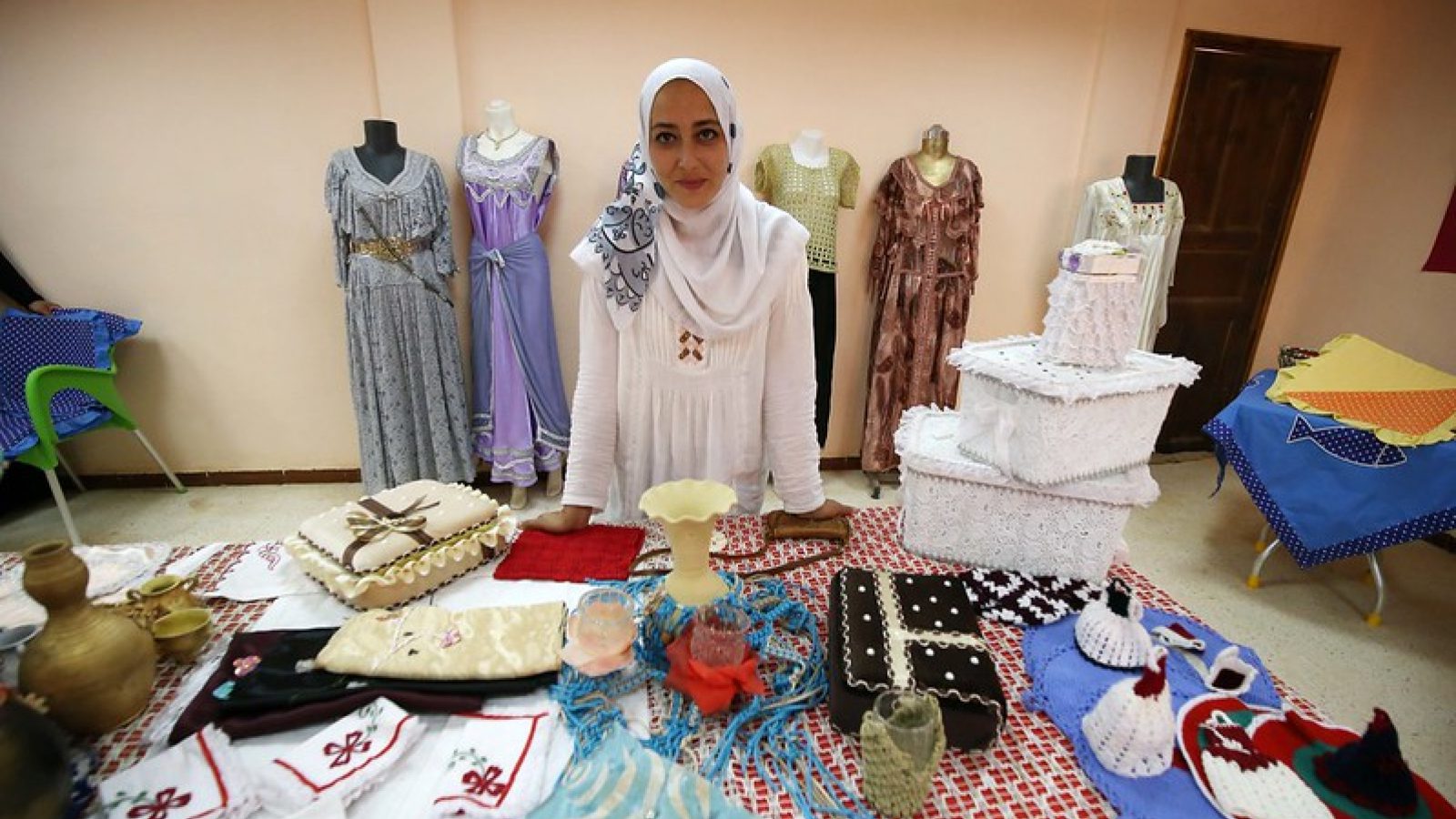
Handcraft, heritage and quality
For Dalila Belmecheri, PAP-ENPARD has set new standards for rural development in the Laghouat wilaya. “There is a real awareness, a new way of seeing things. The richness of our heritage can create new economic opportunities if we take the trouble to value it.” Dalila comes back to her own personal experience: “with the little means that we have, it has been possible to sell products that are now in houses all over the world. My dream is to see products from Laghouat sold in the biggest cities. The women of my region do wonders, it’s up to us to know how to develop them to offer them a wider clientele,” maintains the president of the Kheima of One Thousand Crafts.
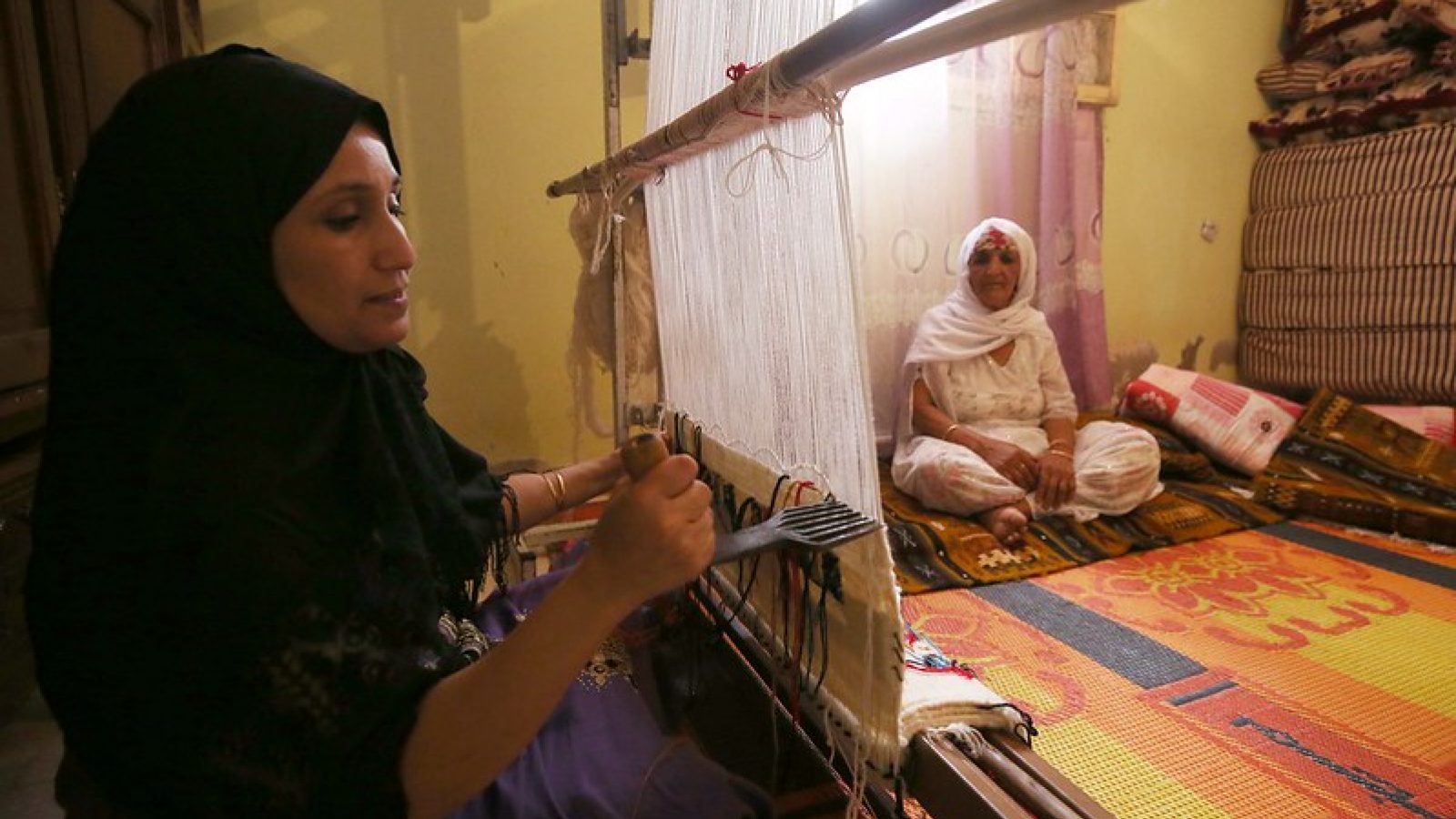
Khedidja, the carpet weaver
Khedidja learnt to weave carpets in Ghardaïa, one of the seven cities in the valley of the M’zab, where she is from. Sitting cross-legged, her mother-in-law watches her pack the threads of the carpet with her khelala, that big, curved comb with long steel teeth. Khedidja knows perfectly how to weave carpets from her region of origin and those of Laghouat. She also acquired this know-how very young, thanks to her mother. “Working with Dalila’s association allows me to bring extra funding into my home and also gives me some independence. It would have been impossible for me to buy the wool, make the carpets and resell them. The association gave me the primary material and I give it the finished product. In the end, I am paid for the effort I put in,” Khedidja explains. Meticulous, Dalila checks minutely the bedside rugs, these little carpets that her clients snatch up. She explains that she has given up on the idea of producing large carpets, purely for commercial reasons. “The tourists who come to Algeria want to go home with a carpet. However, this purchase becomes problematic because of the weight and size of our carpets. It’s not easy to get on the plane with a heavy, thick zarbia. That is why I only do bedside rugs. They are light and fit in a suitcase.”

Social entrepreneurship, a familial tradition
Now it’s time to return to Tadjrouna for a meeting about local gastronomy. An immersion in the culinary heritage of the high plateaus, led by Aïcha, Dalila Belmecheri’s mum. The president of the Kheima of One Thousand Crafts association starts the presentations with a little story: “It was my mum who made me want to get interested in our culture and crafts from the Laghouat region. She was also the one who encouraged me to go to artisans and make a commitment to the world of associations.”
Seated behind a low table, Aïcha smiles as she watches her daughter, then goes straight to the heart of the matter by listing an inventory of basic products used to prepare local dishes. Smid (durum wheat semolina), ghars (soft dates), han (rancid sheep butter), klila (a sort of hard curd cheese from sheep’s milk), hermass (small dried apricots)… Aïcha begins preparing rfiss de Laghouat, a dish traditionally served at wedding ceremonies. On a plate she mixes ghars, han and klila, kneads it together and makes little sausages. “Unlike in other regions of Algeria, we don’t use semolina in our rfiss. It’s not just a dish for feasts.
Before retiring and dedicating herself to her passion, Aïcha was the manager of a local public enterprise. Today, she makes the most of her free time by preparing dishes and patisserie which families from Tadjrouna order for wedding ceremonies. “I have a very decent pension, this activity above all allows me to pass on and make people love our gastronomic heritage,” Aïcha insists.

Couscous, wool and heritage
Couscous remains the main dish of Algerian and North African inhabitants. Inhabitants of the Laghouat region don’t deviate from this rule, whether they are nomadic or sedentary. Made from durum wheat semolina, the preparation of couscous grains needs dexterity and energy. Dounia has made this her main activity. “There are many industrial couscous brands in shops, but people prefer to buy traditionally rolled couscous. It has a better taste and keeps better and for longer,” this mother-of-five says.
Dressed in traditional laghouati costume, Achoura prepares wool. She is one of the artisans from Tadjrouna who weave carpets at the heart of the Kheima of One Thousand Crafts association. Achoura reproduces gestures that go back to the beginning of time. “I have been making carpets since I was very young. This skill was shared with me by my mother who had it from her mother and so on. It’s nothing exceptional, all the families in the region wove their own carpets. This tradition is starting to be lost because of the work it requires,” Achoura explains while combing tufts of wool on a large comb with a wooden frame.
Creating a carpet needs a succession of skills. After preparing the wool thread, Achoura starts weaving the threads by attaching them between two stakes. The loom Achoura uses is made from metallic structures. It is certainly the most “modern” piece of equipment of all those she uses daily. “I weave different types of carpets and I also know how to weave burnous and kachabias from dromedary hair. These are very sought-after products,” Achoura says, throwing the shuttle between the two sides of her loom. Before meeting Dalila, this mother-of-five worked for a centre making artisan products. “I opted for the formula the association offered me as it suits me better. I weave at my own speed and I am sure to get paid as soon as I fulfil the orders.”
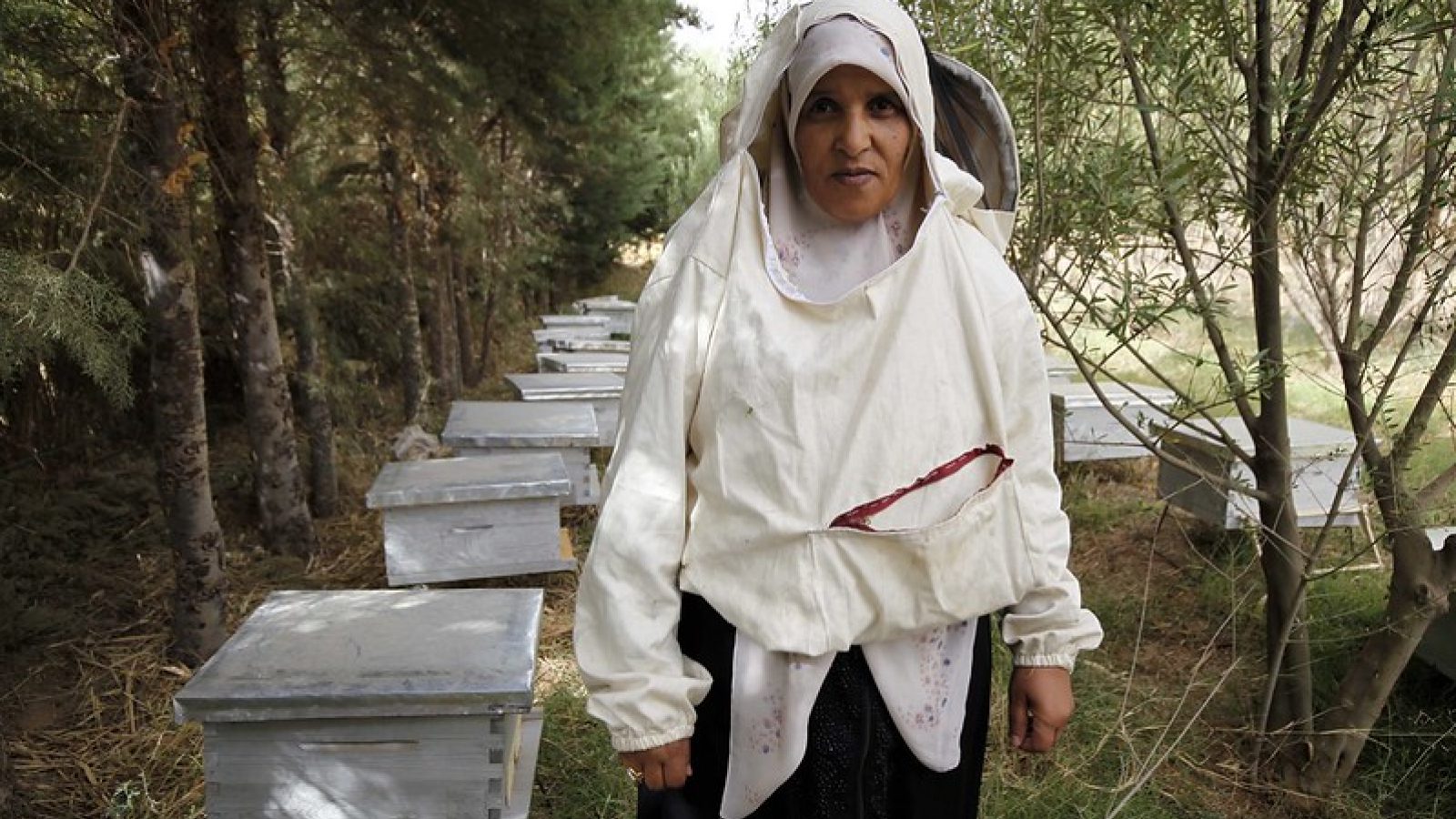
Wonder-craftswomen
The Kheima of One Thousand Nights network does not just include artisans, it is also made up of local women’s associations. Next we head to Taouiala, in the north west of the Laghouat wilaya, to meet the members of the Nour (light) association. Located at an altitude of 1,239m, this village is known for the beauty of its natural sites. Notably the waterfalls which flow all year long and which are a popular place for cooling off during heat waves. Chaïaa runs the Nour women’s association of Taouiala. Protected by her suit, she takes care of the association’s ten hives which it was given by the Laghouat forest conservation organisation. “Apiculture is a new profession for me, I’m more used to weaving carpets. We are lucky to have large orchards where the bees can gather nectar, so it is obvious that we should produce honey,” she says.
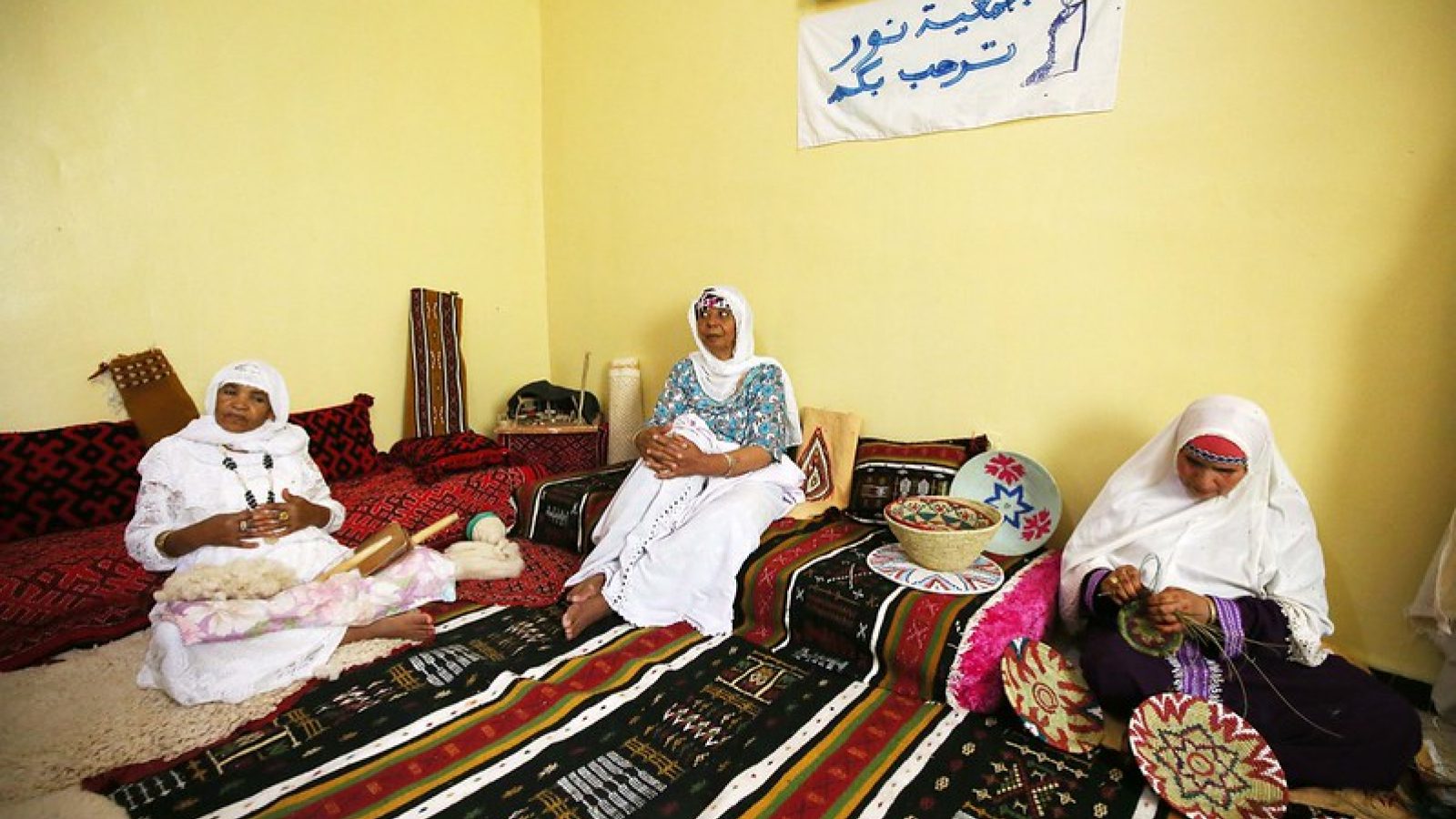
A bridge between past and future
Next we head to Chaïaa’s house where Fatima, Fatma and Oum el Kheir await us. The living room is the headquarters of the Nour association and an exhibition space for the products created by the artisans. Carpets, bedside rugs, cushions and houli (mattress covers) are displayed around the small room. Objects made from halfah grass, a steppe plant with many uses, are also on show. Fatima and Fatma work with wool. In Taouiala, the artisans weave carpets typical of the Amour Range, a mountain range of the Saharan Atlas, separating the Tell Atlas from the Sahara. This region is one of the coldest in Algeria. The winters are harsh and snow isolates the villages and hamlets. Here, carpets are not just decorative objects carrying symbolism. Some, like the hayek and hambel also protect the whole family from the glacial cold.
Oum el Kheir makes tbags, multicoloured platters made from halfah grass. This plant, which grows in tufts on the high plateaus, is also used to make mats and paper. Cheerful, Oum El Kheir enjoys making halfah products. Dalila appreciates her work. “The tbags are really beautiful. I will take some when I next visit. I also need some lampshades. That’s a product that is very sought-after,” notes the president of the Kheima of One Thousand Crafts association. Oum el Kheir has a wcham on her forehead, the traditional protective tattoo. The artisan blushes when this drawing is mentioned. “I don’t know what it represents. I just know that I have had it since I was four years old.” Only women born before independence still carry a wcham on their face, hands or the top of the chest. This tradition has not existed for several decades. A part of heritage engraved on the skin of Algerian men and women which will soon disappear.
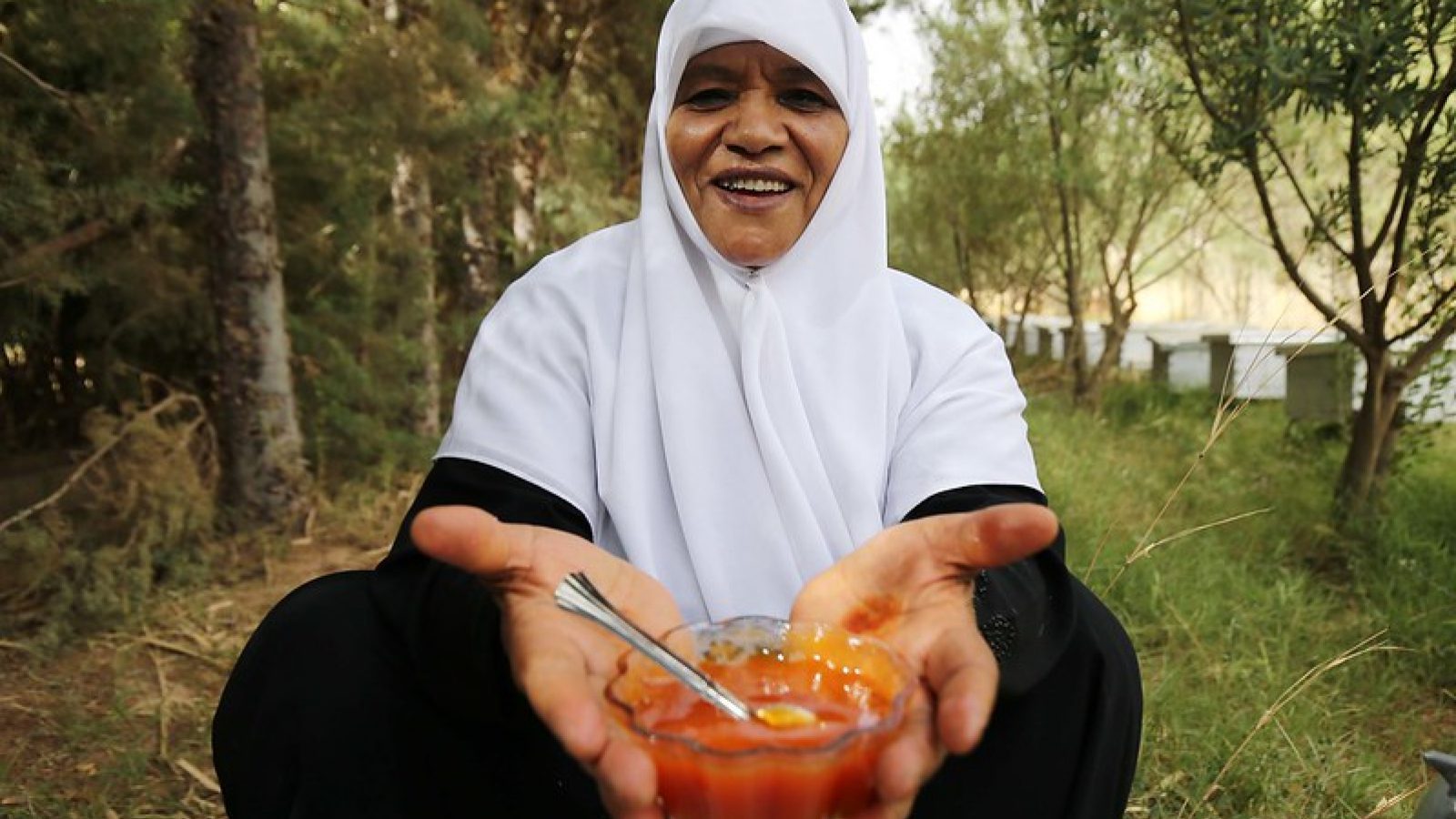
A passion called jam
Chaïaa joins her neighbour Meriem to take care of the association’s hives. They are assisted in their work by the village’s young apiculturists. “We are in an apprenticeship phase. In a few months we will have honey produced by the women of the Nour association,” Chaïaa confirms. This “100% female” honey interests Dalila Belmecheri. “It will be put in jars which mention the Nour association. This will be a quality honey as the bees gather nectar from the Taouiala orchards. The Nour association has important potential in terms of natural products and local gastronomy.” Meriem, the preserves specialist, has taken off her beekeeping suit. She searches in her bag and pulls out jars of preserves. The tasting session has started: apricot jam, robb (date molasses) and gataa el bared (a drink made from dried apricots). “All these products are made with fruits from the region, except the soft dates which we bring from the oases. Everything is natural, there are no chemicals or preservatives,” Meriam says. To make the robb, Meriem boils gharss, soft dates used in traditional patisserie. Once cooked, the dates are filtered, then pressed. The liquid is then cooked over a low heat to make robb. This molasses, rich in vitamin A, phosphorus, calcium and iron, can be consumed as it is or spread on flatbread. Gataa el bared is drunk by nomads from the Laghouat region. “This juice allows us to resist thirst, that’s why we prepare it during the month of Ramadan. It is made from dates and hermass, to which we add aromatic herbs,” says Meriem. Over the last few years there has been a real enthusiasm for these artisan products. A market within reach of the Laghouat artisans.
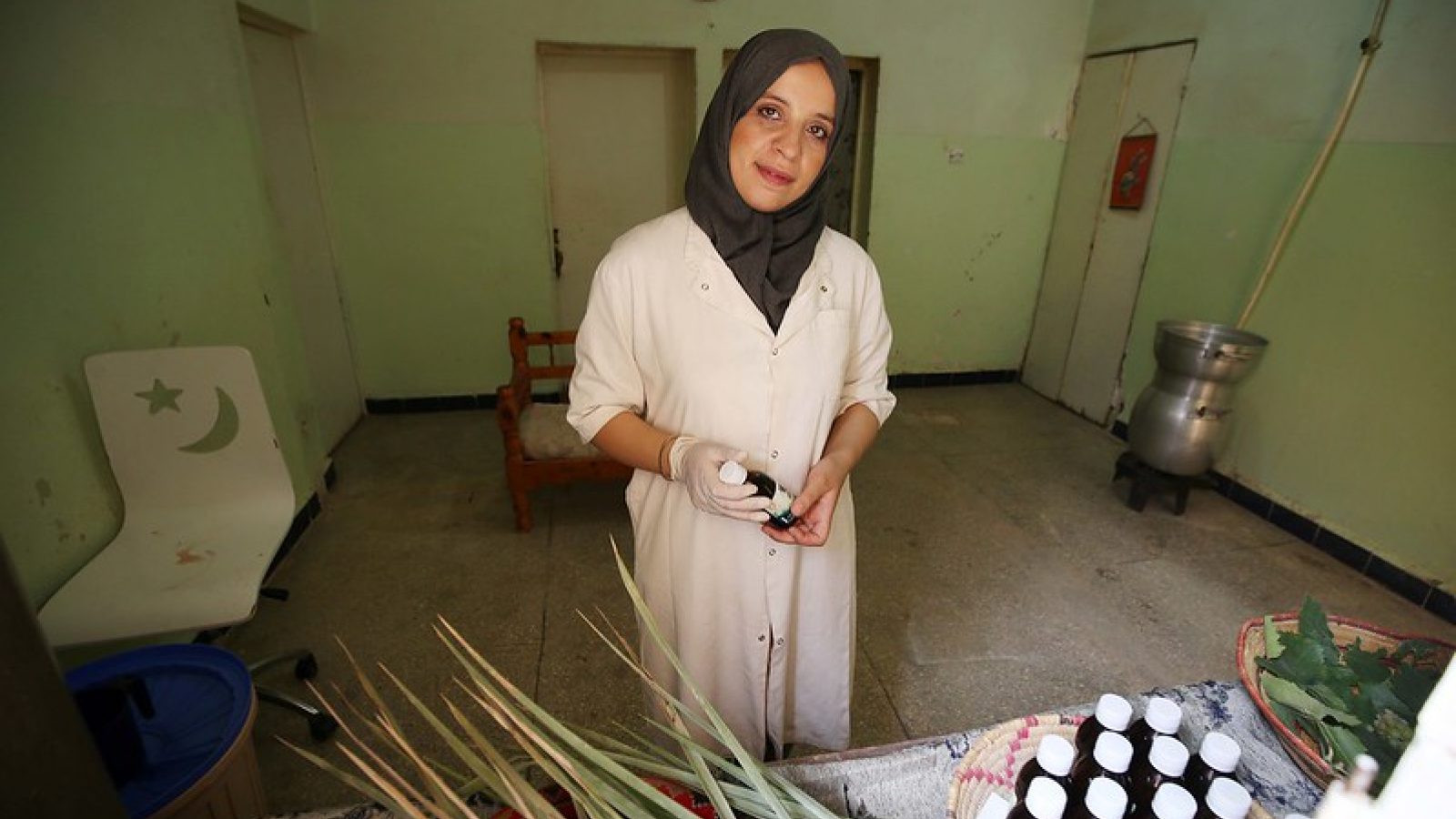
From agronomy to entrepreneurship
Creating a network of artisans to offer quality products to their clients is a long-term piece of work. Dalila Belmecheri is involved on a daily basis, going from village to village. Today she is heading to Tadjemout, a large pastoral town located between Aïn Madhi and Laghouat, to meet Amina Lakhdari who makes vinegar. The biologist explains the use of her products to the president of the Kheima of One Thousand Crafts association. “These vinegars are very concentrated, they are mainly used in phytotherapy. You have to measure them out with a teaspoon and dilute them in water.” With a double degree in agronomy and biology, Amina Lakhdari started out in this field in 2002, to respond to a pressing request from her doctor father. “My dad is a general practitioner but has always been interested in phytotherapy. But many of his patients to whom he recommended using vinegar complained that they couldn’t find quality products. So he advised me to make some. Today, he is my main client,” Amina says, laughing. After several years of experimenting,Amina now knows how to control the process of producing her vinegars. “I ended up banning all metal utensils, especially large recipients made of galvanised steel. The acids contained in the vinegar attacked the anti-rust layer and this tended to alter the final product. That is why I only use plastic recipients,” the biologist explains, pouring a large cup of red grape must into a plastic vat. “I made this filter from a large tube, it’s perfect for what I need,” she says with pride.Amina Lakhdari is the perfect example of a self-employed person who knew how to combine university research and the promotion of local products. “I took advantage of my studies in agronomy and biology to perfect the fermentation process. The vinegars I create are made exclusively from organic fruits. The organic quality is guaranteed by laboratories in Ghardaïa and Ouargla, to whom I send samples before bottling,” she confirms. Amina makes vinegar from grapes, apples, aloe vera and dates. “Using dates requires a certain expertise as each variety makes a different vinegar.” On the high plateaus and in the desert, nomads consume it for its nutritional value and for its long shelf-life,” she notes.

PAP ENPARD to promote local resources and productions
The Kheima of One Thousand Crafts venture is the fruit of a combination of Dalila’s dreams and commitment and the expertise of a group of professionals led by Sid Ali Touati, head of the Laghouat wilaya’s PAP ENPARD office. “The Kheima of One Thousand Crafts concept was developed as part of the PAP ENPARD. The association was created as part of this European Union programme. Dalila underwent association management training and we supported her in setting up her network of women artisans,” states Sid Ali Touati. The PAP ENPARD targeted four wilayas: Laghouat, Sétif, Tlemcen and Aïn Temouchent. With a budget of 20 million euros, that is 10 million euros for each of the Algerian and European parties, the programme must be closed in November 2019.
As for the Laghouat wilaya, Sid Ali Touati indicates that the objectives are at an appreciable rate. “They will be reached, even exceeded for some.” The office head goes back to the work of co-operating with local authorities. “The role of Forest conservation was essential. The Forest conservation officer, who represents the administration in this programme, very quickly understood the importance of the PAP ENPARD. Co-operation, by the way, is excellent.” In addition to the Kheima of One Thousand Crafts, the programme enabled the creation of the wilaya’s agroecological association “El Ghouta”. “This second association is tasked with preserving and promoting the rich agricultural heritage of the Laghouat wilaya,” says Sid Ali Touati. Two associations of professional apiculturists were also created in the communes of Bennacer Benchohra and Ksar el Hirane.
The presidents of the two associations, “Kheima of One Thousand Crafts” and “El Ghouta”, participate in the training process as Territorial Development Advisers (CDT: Conseillers en développement territorial). In addition to the two representatives of the associative movement, there are ten other CDTs being trained in Laghouat and representing the local administration: Three from forest conservation, two from the agriculture department, two from the professional training department, two from the tourism and handicraft department and one from the chamber of agriculture. “We organised several co-ordination meetings between the group of CDTs. The objective being to be able to work within a concerted framework to deal with the various issues in the Laghouat wilaya. Rural development needs to be addressed in a cross-sectoral framework. This is one of the most important aspects of the PAP ENPARD,” confirms the head of office.
At the heart of PAP ENPARD’s work is the strengthening of the abilities of project leaders in rural areas to promote local resources and productions. So, since 2018, Dalila has benefitted from a hundred training days and support from a dozen Algerian and European experts. The subjects tackled cover: structuring of associations, rural entrepreneurship, territorial animation, communications and advocacy. She also received theoretical and practical teaching on pedagogical engineering and training to be able to share her knowledge and know-how with other members of the association.